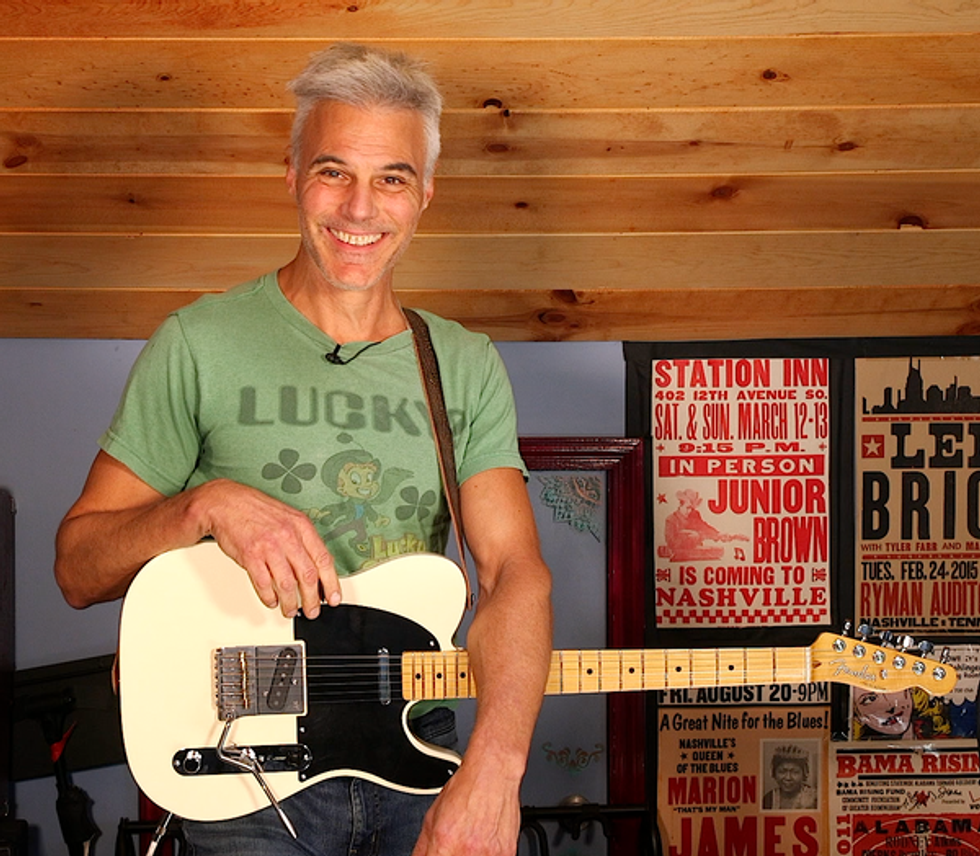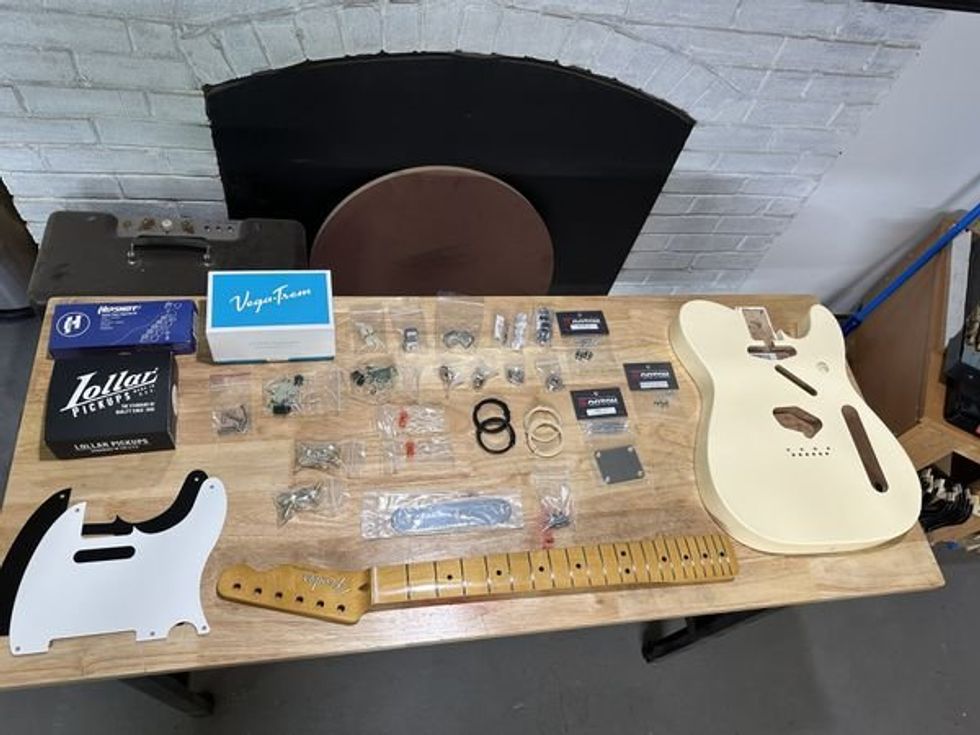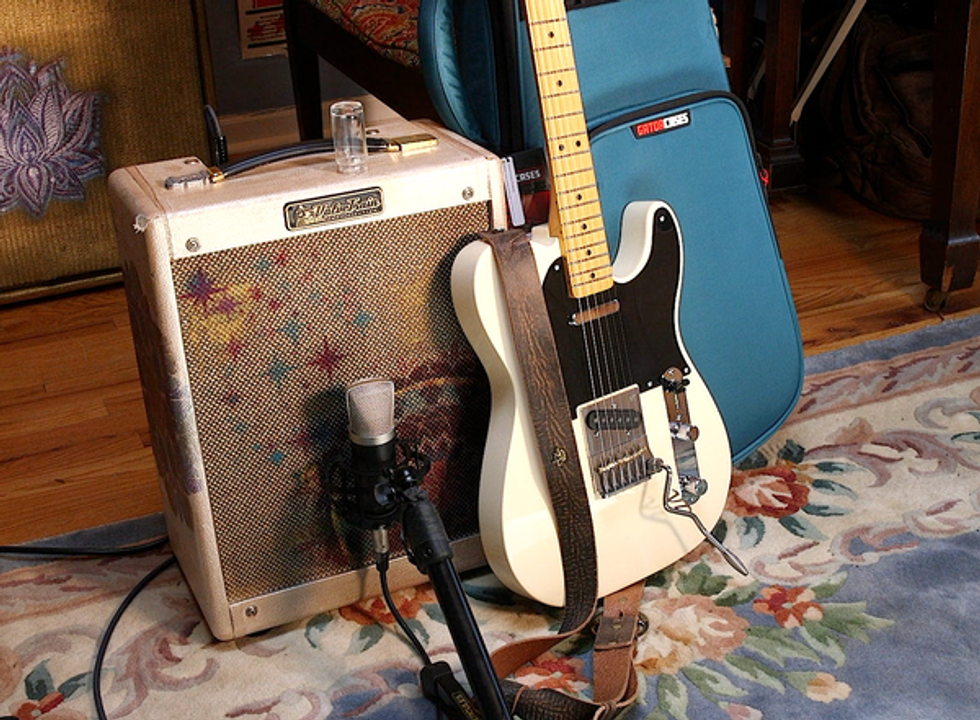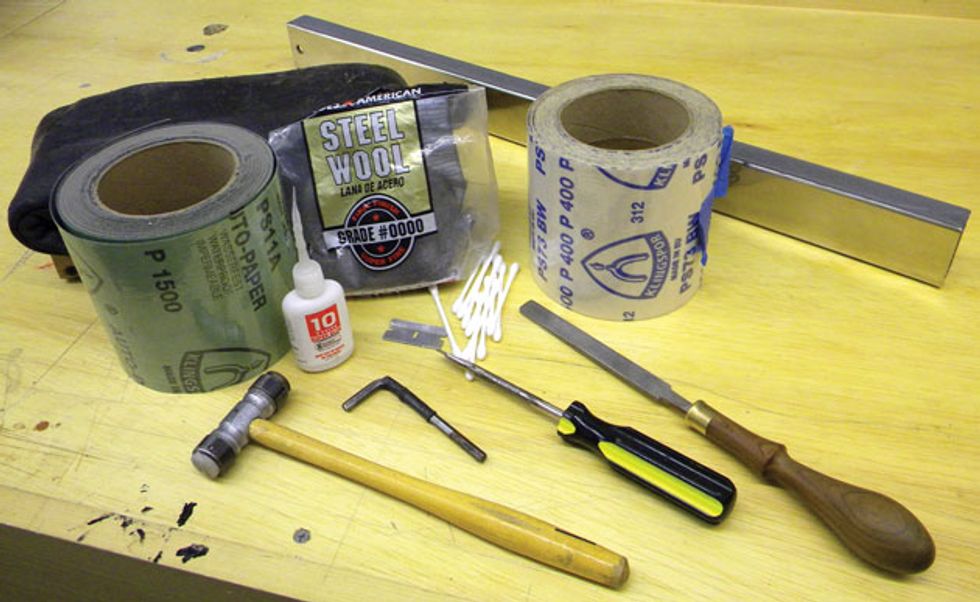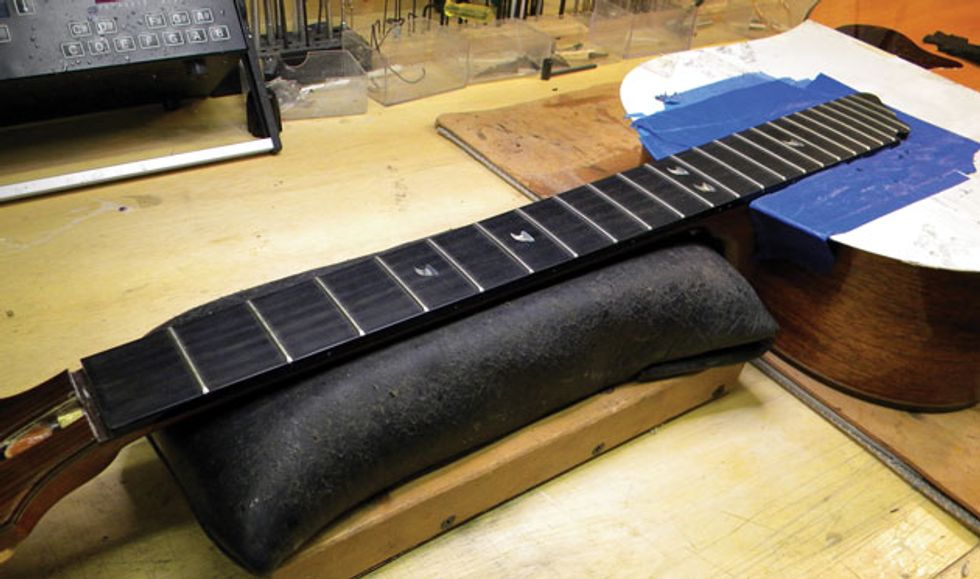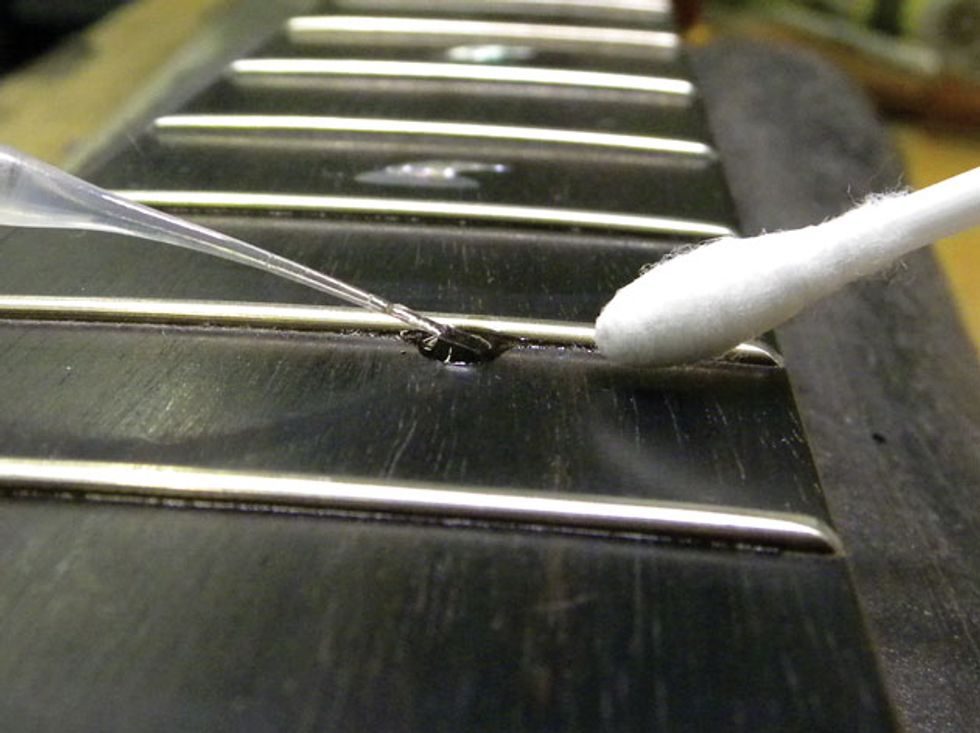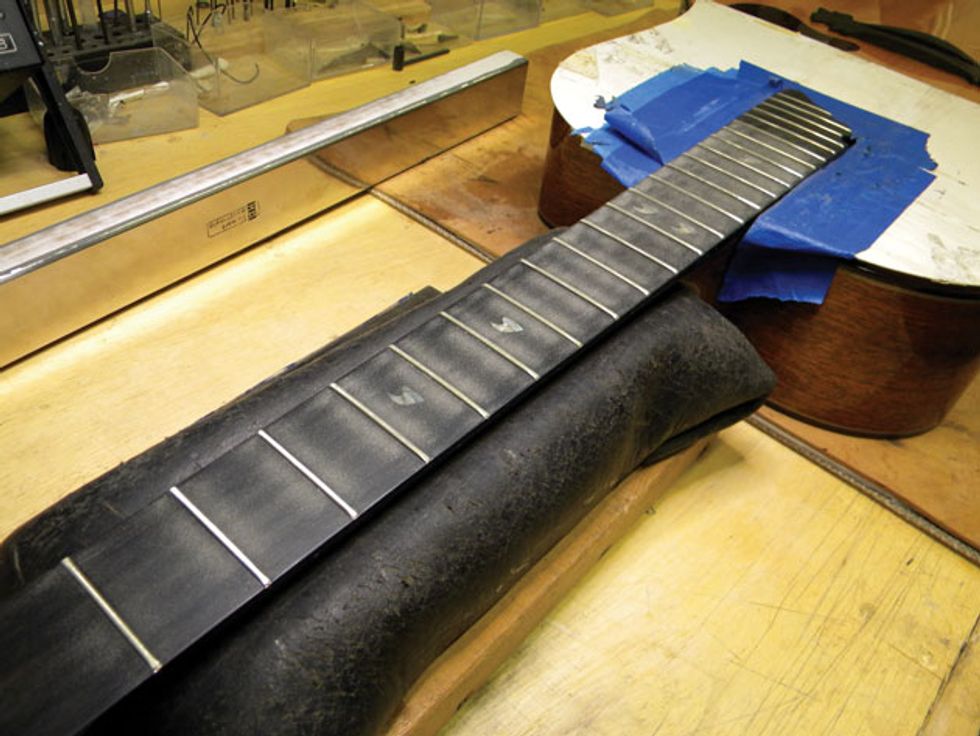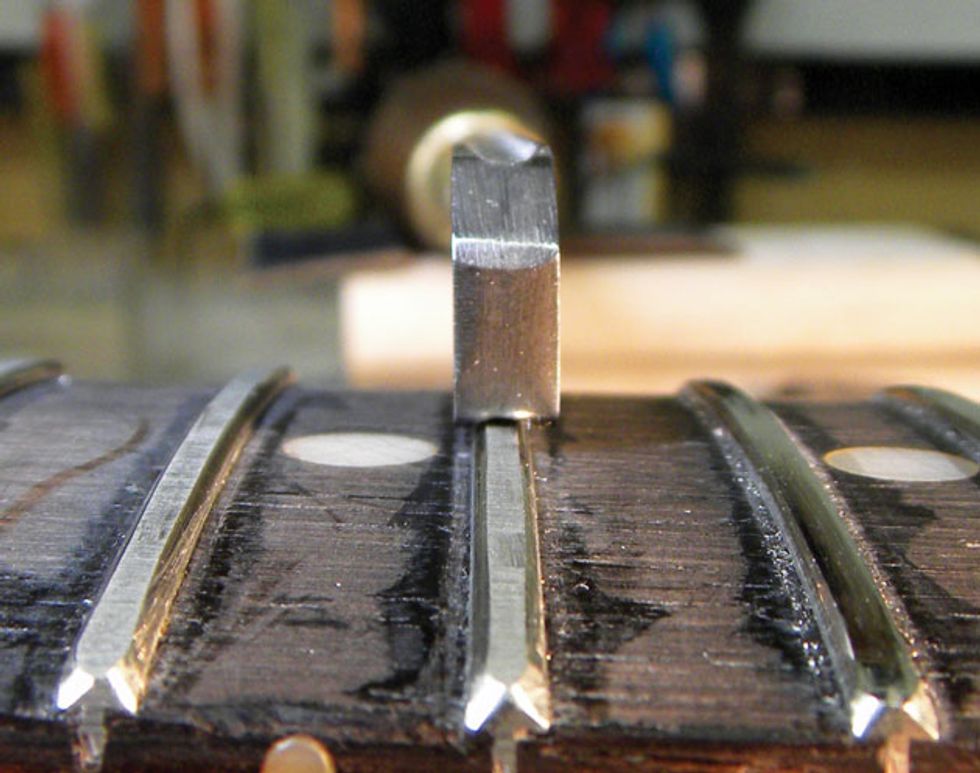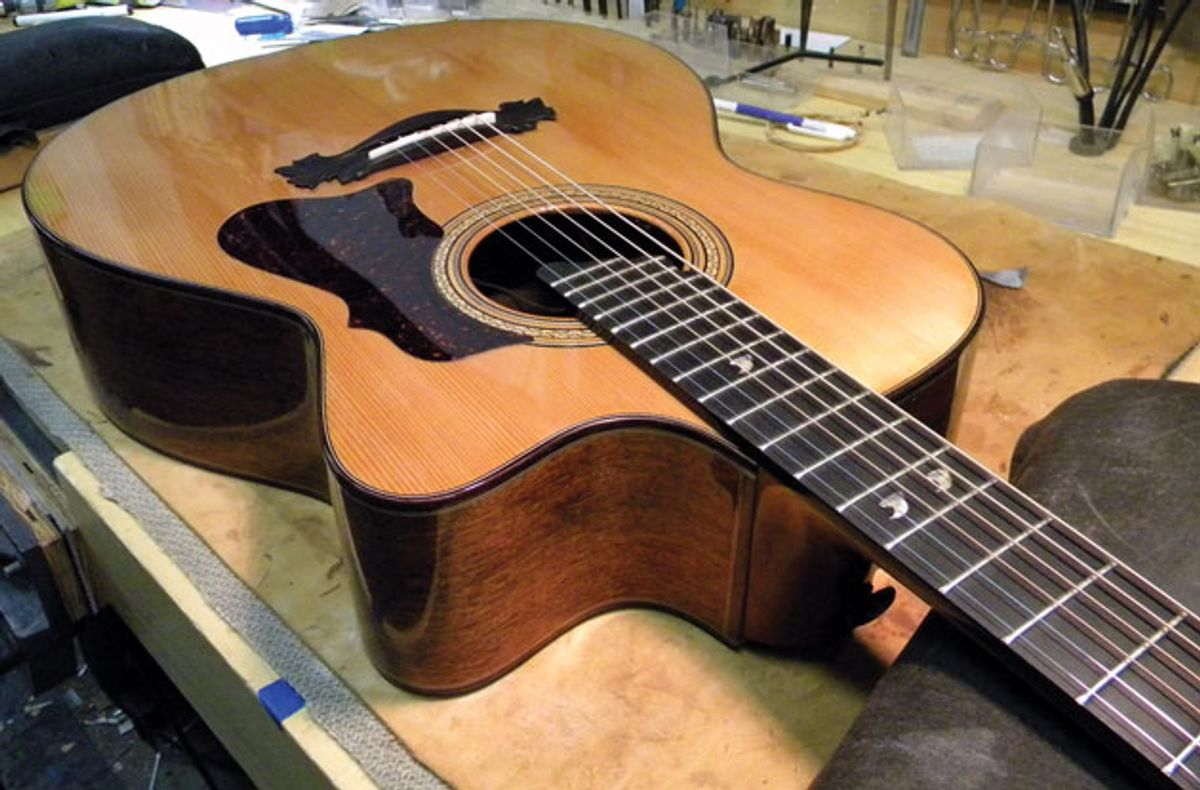
If it’s hard to coax rich tones from your acoustic, your guitar may need to have its frets leveled.
When you play your guitar, pushing its strings down against the frets causes them to wear. Depending on how hard you grip the strings, this metal-to-metal contact can cause the frets to develop divots or small depressions. As a guitar’s frets become uneven, vibrating strings lose sustain and clarity, intonation gets compromised, bending can become difficult, and it can feel like you’re fighting to get good tone from your guitar.
Eventually you may need to replace worn frets with new ones—a job for a professional—but before you reach that point, there’s a lot you can do yourself to keep your guitar in good playing condition.
People use different terms to describe basic fret maintenance. I’ve heard it called fret leveling, fret treatment, recrowning, grind and polish, and fret milling. Whatever you call it, the process and goal is always the same, and that is to reshape and recrown the frets so they have an equal height (with the exception of the last five to eight frets, which I’ll explain in a moment).
But first, a word of caution: Fret leveling is not a casual project. Unlike adjusting pickup height or intonation or a truss rod, it involves actions that can’t be undone. To level and recrown frets, you need the proper tools, a steady hand, and a lot of patience. The tools alone will probably cost more than hiring a pro to do the job on a single guitar. If you have several guitars and an innate interest in maintaining them, learning to level frets can be worthwhile. But if you’re not prepared to invest in the tools or take the time required to execute this delicate task, then do yourself a favor and take your guitar to a qualified tech.
That said, even if you decide to hire someone to level your frets, understanding what’s involved can be useful—especially if you buy used guitars or deal regularly with guitar techs. Knowledge is power, as they say, so read on.
Project overview. To illustrate the fret leveling process, we’ll use a Manea jumbo acoustic a client recently brought in for work (Photo 1). It’s a great-sounding instrument, but over time the frets have become uneven and many are no longer properly seated in the fretboard. Our task is to seat those frets securely into the fretboard, and then level and crown all of them.
Photo 2
Before you start a project, it’s important to gather the necessary tools and supplies. Photo 2 shows the items I use for a fret level: a 24" fret leveling bar, a two-sided fret crowning file (designed to round the top of both small and medium fretwire), a fretting hammer, a truss rod wrench, self-adhesive sandpaper (400 and 1500 grit), thin superglue, razor blades, 0000 steel wool or Planet Waves fret-polishing paper, and a flathead screwdriver.
You can purchase most of these tools and materials at a home improvement store or online from such retailers as Stewart-MacDonald.
You need to immobilize the guitar to perform accurate fretwork. To support the neck, I use a 25-pound bag of buckshot wrapped in leather. Alternatively, you can use a bag of sand that’s similarly wrapped. I also rest the guitar body on a piece of leather to protect the instrument and keep it from sliding around.
Photo 3
Finally, I strongly recommend placing a guard over the soundboard in case you slip with a tool while leveling or recrowning the frets. This protective surface—a thin sheet of plastic or even cardboard—should cover the top around the fretboard extension (Photo 3). Make sure the guard is thin enough that you can access the frets, yet thick enough to provide protection from sharp tools. You can secure it with blue painter’s tape.
Photo 4
Size matters. Before you begin grinding on the frets, you need to confirm they’re tall enough to level and recrown. To do this, I use a luthier’s digital caliper. Available from stewmac.com, the tool is designed to let you measure fret height right off the fretboard. On this Manea, the fret height measured .043"—a good height for frets on an acoustic guitar. If the current frets measure less than .038", they’ll be too difficult to recrown after being leveled, and that means new frets are required.
Tap and seal. After removing the strings, place the guitar neck onto a secure platform, and then remove the nut (I demonstrate removing a nut in this PG DIY video, “How to Convert a Flattop into a High-Strung Guitar”).
Next, check the frets to make sure they’re securely seated in the fretboard. Shine a bright light along the fretboard to see if any frets have sprung loose from their slots. The flat bottom of the crown should sit flush to the wood. If you see a fret that’s come up, gently tap it down with a fretting hammer and then run a bead of thin superglue along each side of the fret to hold it in place.
Drop Off and Fall Away
Most acoustic guitars have what’s called a fall away or drop off at the end of the fretboard where it extends over the top. This is a result of the neck angling down very slightly into the guitar to provide room for the strings to vibrate without hitting the frets. If the fretboard doesn’t drop off, it could be a sign of a low neck angle. If you see this on your guitar, I recommend you take it to a qualified luthier for advice. Correcting low neck angle requires major surgery. At the very least, the frets over the fretboard extension may have to be dramatically filed down.
Note: Whenever you have superglue in one hand, always have a Q-tip in the other. The Q-tip lets you quickly soak up any excess glue (Photo 4). Be very sparing when applying glue along the frets. If you use too much, it can spill over onto the neck. Thin superglue travels fast, so be ready with your Q-tip.
Leveling the frets. Once the frets are all seated, it’s time to begin leveling them. Different luthiers have different techniques for doing this. Here’s my approach: Place the leveling bar across the frets and adjust the truss rod until the bar is touching most—if not all—the frets. This process can take several attempts, so be patient.
Once the leveling bar is touching as evenly as possible, attach 400 grit self-adhesive sandpaper to the leveling bar, place it perpendicular to the frets, and then gently begin sliding the leveling bar along the frets. I like to start on the bass side and gradually work my way to the treble side of the fretboard. Don’t press too hard, just skim the surface of the frets with slow, controlled motions.
After a few passes, check the frets for scuff marks. Again, use a bright light to see if you are contacting all the frets evenly. If not, then you may have to readjust the truss rod. Keep using your leveling bar to remove more fret material.
Photo 5
About those last few frets. When the frets are perfectly even, they should all have file marks with the exception of the last five to eight frets (Photo 5). If those last several frets don’t have any file marks, but the rest of the frets do, that’s okay. It just means the fretboard has what’s called a fall away or drop off. For more details, read the “Drop Off and Fall Away” sidebar.
However, if you see you’re filing the last few frets, but not the frets in the middle of the fretboard, there’s a problem. Either the truss rod is too loose, which creates a bow or dip in the middle of the neck, or the fretboard has a “kick-up.” The latter is a condition that requires professional surgery to repair.
Recrowning. To ensure that a guitar intonates correctly and plays comfortably, the newly flattened frets need to be shaped to provide a narrow, precise point of contact for the string. This is called recrowning.
Photo 6
Fret-crowning files have concave grinding surfaces that run along their edge. Typically each edge is a different size to accommodate different widths of fretwire (Photo 6).
Once you choose the appropriate edge of the file to fit your fretwire, place the file along the top of a fret, and glide it forward, filing in only one direction. Use slow, gentle strokes to remove metal from each side of the fret, while leaving the top untouched. The goal is to produce a nicely rounded playing surface with a peak that runs along the center of the fret.
After every few passes, clean your file with a wire brush to prevent metal build-up in its teeth. Repeat this process for every fret. Some frets will take longer than others to crown, so take your time and be thorough. When the job is finished, you should see a thin line of scuffmarks running along each fret that’s about the width of a high-E string.
When the frets are all recrowned, change the sandpaper on the leveling bar to 1500 grit. Using a light touch, glide the bar along the frets parallel with the neck to confirm that the fret tops are all level. If they are, then glide the leveling bar over the frets once more, this time working along the length of the frets, perpendicular to the neck. This will remove the scuffmarks and smooth out any inconsistencies on the crown of the frets.
Finishing touches. Now we enter the clean-up phase. To remove any tool marks left in the wood by your recrowning file, carefully scrape the fretboard with a razor blade. Exercise caution and don’t push too hard. If you slip, you might gouge the fretboard or even the frets you just worked so hard to reshape. With any tool marks removed, you’re ready to polish the frets with 0000-steel wool to make them look perfect.
Tip: Whenever you use steel wool around magnetic pickups, first cover them with painter’s tape to prevent little metal fibers from collecting on the pole pieces.
Finally, reinstall the string nut, put on a new set of strings, and enjoy the feel of freshly leveled, crowned, and polished frets.
The Man in Black returns with the unreleased Songwriter album. John Carter Cash tells us the story.
“The Man Comes Around” is a much-played song from the final album Johnny Cash recorded before his death in 2003, American IV: The Man Comes Around. Now, the Man in Black himself has come around again, as the voice and soul of an album he initially cut in 1993, titled Songwriter. It hits the street on June 28.
For fans who know Cash only through his much-loved American Recordings series, this is a very different artist—healthy, vital, his signature baritone booming, his acoustic playing lively, percussive, and focused. This is the muscular Johnny Cash heard on his career-defining recordings, from his early Sun Records sides like “Cry! Cry! Cry!” and “Folsom Prison Blues” to “Ring of Fire” and “Sunday Mornin’ Comin’ Down” to later, less familiar hits like “The Baron” and “That Old Wheel.” In short, classic Cash—the performer who became an international icon and remains one even 21 years after his death.
I recently visited the Cash Cabin recording studio—a log cabin on the Cash family property in Hendersonville, Tennessee, that was originally built as a sanctuary where Johnny wrote songs and poetry—with PG’s video team of Chris Kies and Perry Bean to talk about Songwriter with John Carter Cash, the son of Johnny and June Carter Cash.
In addition to getting the lowdown on Songwriter from John Carter Cash, he showed us some of the iconic guitars—including original Johnny Cash lead guitarist Luther Perkin’s 1953 Fender Esquire and a Martin that was favored by the Man himself—that dwell at the busy private studio. Check out this visit.
Jesse Dayton uses an EP-3, from the first generation of solid-state Echoplex models, on the road and in the studio.
From Page to Eddie to Gilmour, the comparatively impractical Maestro Echoplex has nonetheless served its masters well. And for some, like our 6-stringing contributor, it still does.
Feast your eyes on the missing link. I give you the coolest contraption to ever run between a guitar and an amplifier: the Maestro Echoplex.
The cool factor for this historic piece of gear is so off the chart that I’m always a bit shocked when players, young or old, are not familiar with this marvelous old-school tape-echo device. But no, I’m not writing this to copy and paste Wikipedia stats on this crown jewel of the guitar-pedal world. (However, if your inner nerdom is anything like mine, it’s worthy of a snoop. All of the Echoplexes from 1959 to the late ’70s sound amazing!) I’m writing to profess to all my fellow guitar gear freaks my undying love for something that was used on so many historical recordings that it’s mind-blowing. And while a big box with an analog tape loop might not be your idea of a great ride-along pal on tour, or even in the studio, truth is, there is nothing else exactly like an authentic Echoplex.
Do you remember the first time you heard that huge swelling repeat sound at the end of “Eruption” by Van Halen? Echoplex. How about the heaviness of Jimmy Page’s guitar on “Moby Dick” by Led Zeppelin? That’s a cranked Echoplex preamp, mis amigos!
The Echoplex design is pretty simple, which is one reason why it’s so iconic. It has actual tape that runs on the top of the unit, records your sound, then plays it back. Remember 8-track tape players? Yeah, kind of like that—except for the recording part. You just crank the slide in the middle—at least on the solid-state EP-3 model that I own—to make the delay effect go fast or slow. It’s not rocket science. But it does also work as a preamp and will enhance the tone of the guitar coming out of your amp like no other unit. Eric Johnson, for example, travels with one in a rack, sans tape, just so he can use the preamp for his classic tone. The Echoplex preamp basically boosts and compresses your signal, fattening it up and providing some EQ trickery that will have guitar players unfamiliar with the device’s charms scratching their heads.
The original Echoplexes come in four flavors: the EP-1, EP-2, EP-3, and EP-4. The EP-1 is the O.G.—the first tape delay ever, with a moving tape head that allows the delay time to be changed. It was made from ’59 to ’62, when the next generation of ’Plex, called the EP-2, not only gave the tape head more mobility but protected the tape itself in a cartridge. The solid-state version was the EP-3, which was used by Van Halen, Page, Tommy Bolin, and Brian May, among others. The EP-4 offered an output buffer to improve impedance-matching with other gear. Today, you can find early generation Echoplexes for anywhere from $1,400 to nearly $2,000, and the EP-3 and EP-4 are in the $600 to $1,500 range, depending on condition.
“I have all kinds of analog delay pedals but none of them compare to the Echoplex.”
There are related devices out there that some vintage-tone-inclined players, like Brian Setzer, prefer. The Roland Space Echo is one, and there’s the Binson Echorec. They’re easier for traveling because the Space Echo has a more efficient tape transport system and the Binson records on a drum rather than a length of tape. David Gilmour from Pink Floyd was a fan of the Echorec. But just remember, it is the original Echoplex sound those models were built to emulate. And both of those artists also used original Echoplex units on a few of their classic recordings.
Sure, you can buy some newfangled digital pedal that tries to recreate the Echoplex, but what fun is there in that? Where’s the potential for tape snarls or the manual cleaning required? After owning several EP-3 Echoplexes and using them in recording studios on countless tracks, touring all over the world with one in cars, vans, RVs, buses, and planes, I can tell you nothing replicates or enhances your tone like an EP-3. And if you do roll out with one, don’t forget Q-tips and a bottle of rubbing alcohol to clean the tape heads when they get dirty. If that doesn’t sound like a good time, then I guess you don't wanna get the sound that fattened up the guitars in power trios like Joe Walsh’s James Gang or on Billy Gibbons’ first five ZZ Top albums.
I have all kinds of analog delay pedals but none of them compare to the Echoplex. Remember, a cool thing about owning vintage gear is not that it’s a piece of handcrafted history, but knowing that Leo Fender or Les Paul himself, or, in this case, Echoplex designer Mike Battle, is never making another one like the one that you own. Don't get overwhelmed or anxious by projecting what could go wrong with it. Get excited about having a piece of gear that can make your guitar sound like almost every classic-rock, blues, and country record ever made.Guest picker Mei Semones joins reader Jin J X and PGstaff in delving into the backgrounds behind their picking styles.
Question: What picking style have you devoted yourself to the most, and why does it work for you?
Guest Picker - Mei Semones
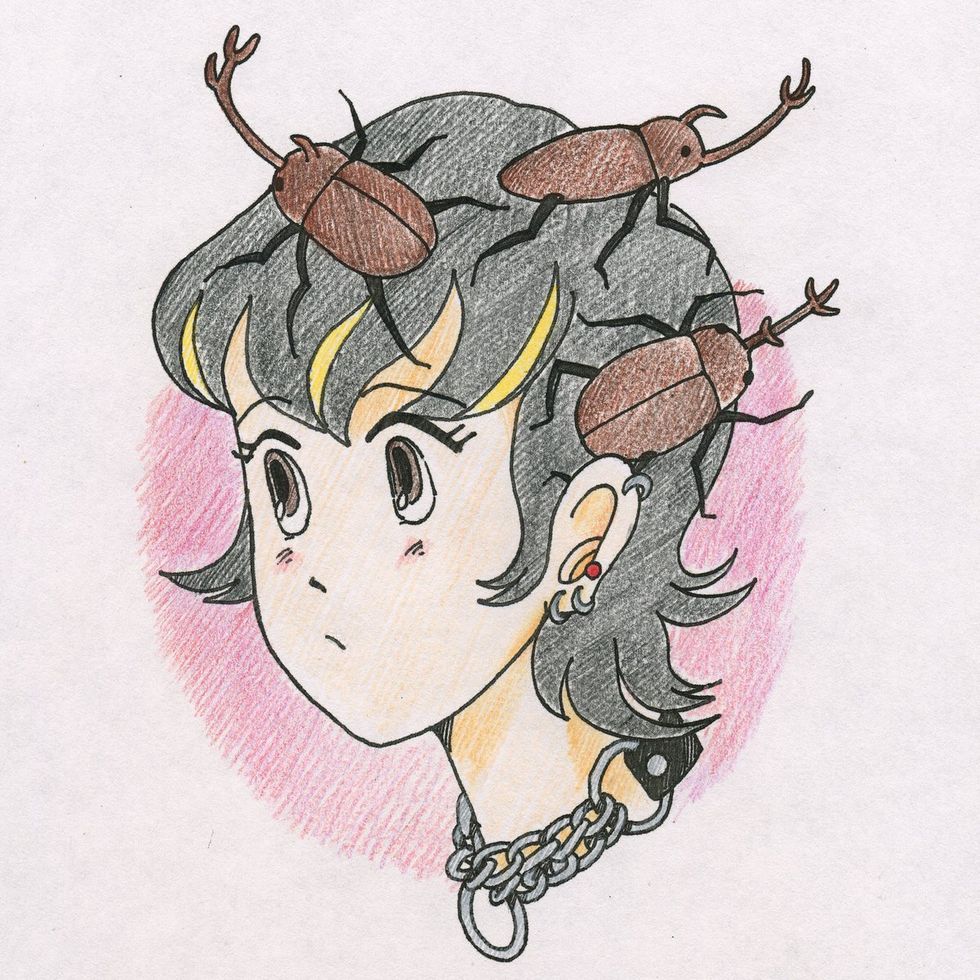
Mei’s latest album, Kabutomushi.
A: The picking style I’ve practiced the most is alternate picking, but the picking style I usually end up using is economy picking. Alternate feels like a dependable way to achieve evenness when practicing scales and arpeggios, but when really playing, it doesn’t make sense to articulate every note in that way, and obviously it’s not always the fastest.
Obsession: My current music-related obsession is my guitar, my PRS McCarty 594 Hollowbody II. I think it will always be an obsession for me. It’s so comfortable and light, has a lovely, warm, dynamic tone, and helps me play faster and cleaner. This guitar feels like my best friend and soulmate.
Reader of the Month - Jin J X
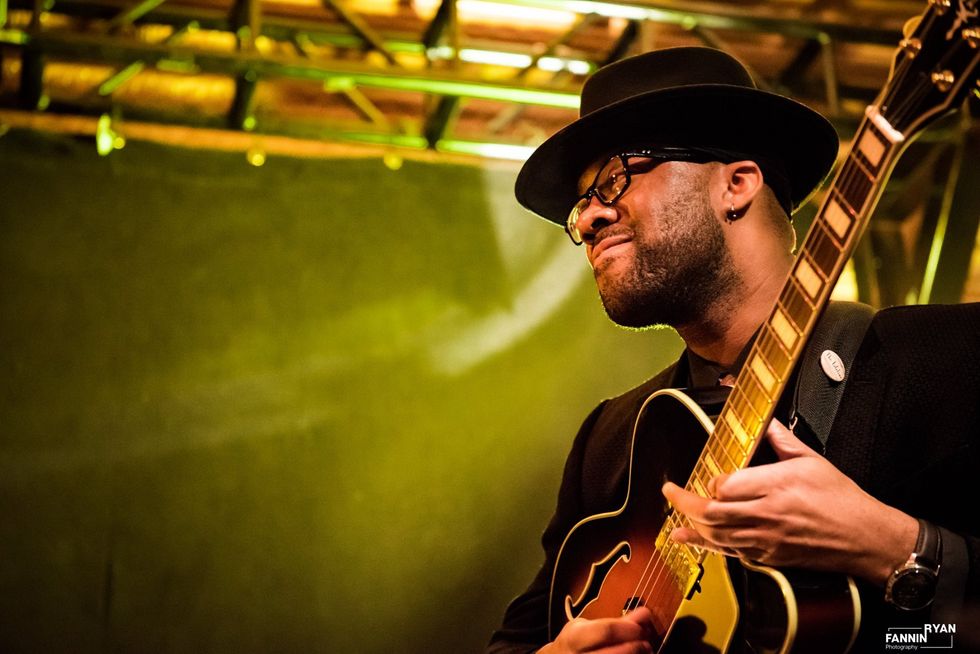
Photo by Ryan Fannin
A: For decades, the Eric Johnson-style “hybrid picking” with a Jazz III for “pianistic” voicings. Great for electric, though not so much acoustic. I’ve been recently learning to use a flatpick, à la Brian Sutton, by driving the pick “into” the string at an angle—which makes me think of Pat Metheny and George Benson, without irony.
Obsession: I’m still focused on understanding the concepts of jazz, neo-classical, and beyond, though I’m also becoming obsessed with George Van Eps’ 7-string playing, flatpicking, hip-hop beats, the Hybrid Guitars Universal 6 guitar, and the secret life of the banjo.
Editorial Director - Ted Drozdowski

A: Decades ago, under the sway of Mississippi blues artists R.L. Burnside, Junior Kimbrough, and Jessie Mae Hemphill, I switched from plectrum to fingerstyle, developing my own non-traditional approach. It’s technically wrong, but watching R.L., in particular, freestyle, I learned there is no such thing as wrong if it works.
Obsession: Busting out of my songwriting patterns. With my band Coyote Motel, and earlier groups, I’ve always encouraged my talented bandmates to play what they want in context, but brought in complete, mapped-out songs. Now, I’m bringing in sketches and we’re jamming and hammering out the arrangements and melodies together. It takes more time, but feels rewarding and fun, and is opening new territory for me.
Managing Editor - Kate Koenig

A: I have always been drawn to fingerpicking on acoustic guitar, starting with classical music and prog-rock pieces (“Mood for a Day” by Steve Howe), and moving on to ’70s baroque-folk styles, basic Travis picking, and songs like “Back to the Old House” by the Smiths. I love the intricacy of those styles, and the challenge of learning to play different rhythms across different fingers at the same time. This is definitely influenced by my classical training on piano, which came before guitar.
Obsession: Writing and producing my fifth and sixth albums. My fifth album, Creature Comforts, was recorded over the past couple months, and features a bunch of songs I wrote in 2022 that I had previously sworn to never record or release. Turns out, upon revisiting, they’re not half bad! While that one’s being wrapped, I’m trying to get music written for my sixth, for which I already have four songs done. And yes, this is a flex. 💪😎
After the success of wiring up the dream stomp station for gigging in Music City, PG's video crew work with Scale Model Guitars' luthier Dave Johnson to construct a T-style partscaster with parts from StewMac, Lollar, Gotoh, VegaTrem, Hipshot, Gator, Art of Tone, and others. And afterwards John Bohlinger takes downtown to Layla's to test it out
Bohlinger's Tele-Style Partscaster!
